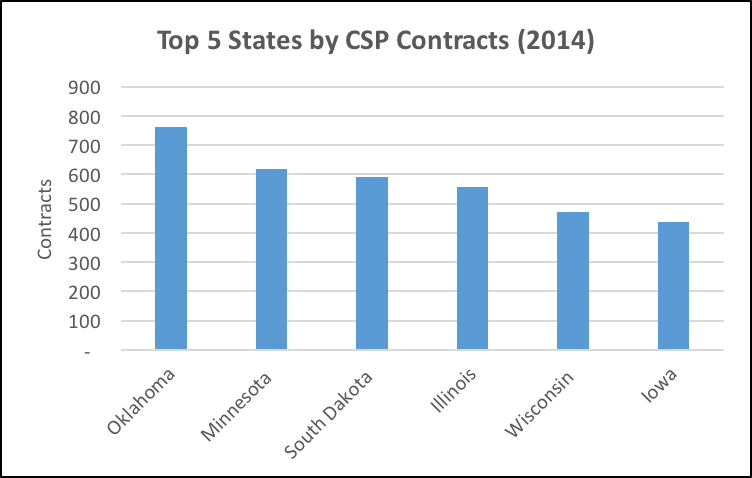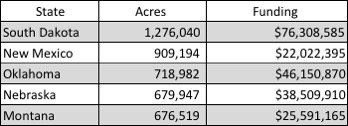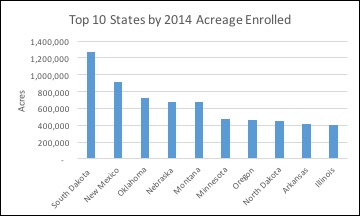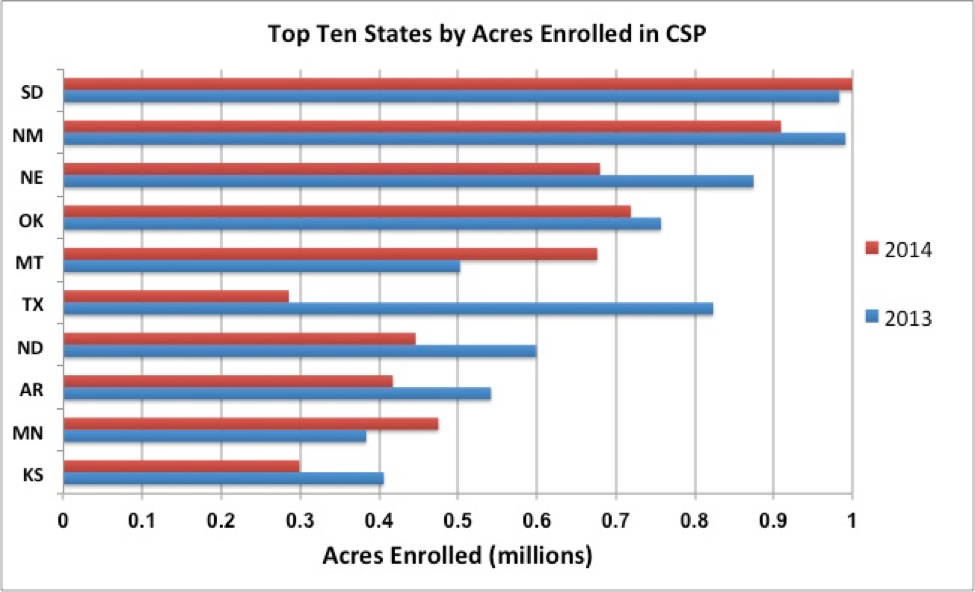Yesterday we dug into data from the 2014 Conservation Stewardship Program (CSP) sign-up period in order to highlight priority resource concerns, conservation activities, and the many ways that CSP participants can provide critical environmental benefits.
In this post, we continue to present 2014 sign-up data and also provide some basic information on how CSP influences land management decisions on farms, ranches, and forests across the country. Statewide trends offer additional insight into how CSP functions and varies throughout the country.
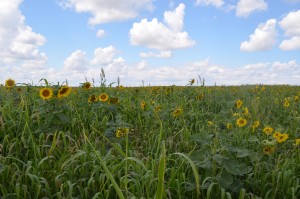
Top States by CSP Contracts, Acreage, and Funding
In 2014, NRCS enrolled over 7,500 farmers and ranchers in CSP. These producers are actively managing advanced conservation over 9.6 million acres and of cropland, pastureland, rangeland, and private forests throughout the country. For the 2014 sign-up, NRCS obligated over $700 million for the new five-year CSP contracts.
Contracts — The top five states where the most farmers and ranchers enrolled in CSP in 2014 were Oklahoma, Minnesota, South Dakota, Illinois, and Wisconsin. Together these states make up nearly 40 percent of all new sign-ups from 2014 and represent a slight shift from overall contract numbers over the previous five years. In terms of cumulative contracts awarded over the past six years, Minnesota, Missouri, Oklahoma, Iowa, and Nebraska have the highest number of farmers and ranchers enrolled, meaning South Dakota, Illinois, and Wisconsin are trending higher on a relative basis for the 2014 enrollment period.
Acreage and Financial Assistance — In terms of the states where the most acreage was enrolled in CSP in 2014, South Dakota, New Mexico, Oklahoma, Nebraska, and Montana top the list. Since the calculations for CSP payment rates factor in the number of acres enrolled for each contract, it makes sense that the top five states in terms of financial assistance corresponds directly with the top five states that received the most financial assistance under the 2014 sign-up period. The chart below lists these five states with their respective acreage and five-year funding obligations. Again, South Dakota is trending higher, with financial assistance some two-thirds higher than the next highest state.
Top 5 States by CSP Acreage and Funding (FY 2014)
In 2014, Connecticut and New Hampshire were the only two states without any new acres enrolled, but both New England states have enrolled significant CSP acreage over the course of the past five years – over 10,000 acres in Connecticut and over 77,000 acres in New Hampshire.
Over the last six years, Minnesota was the largest recipient of CSP funds, with over $396 million allocated for five-year contracts since 2009. The top five states that received funding through CSP since 2009 include Minnesota, North Dakota, Nebraska, Arkansas, and Kansas.
Acres available for CSP enrollment for each state are proportionate to the state’s contribution to the total agricultural land in the United States. South Dakota, New Mexico, Nebraska, Oklahoma, and Montana enrolled the greatest number of acres in 2014, followed by Minnesota, Oregon, North Dakota, Arkansas, and Illinois. The top ten states by acreage enrolled over 6 million new acres of land, or roughly three-fifths of the total 2014 enrollment.
Contracts vary by size and payment rates throughout the country, but the average contract payment was approximately $92,000 obligated for a five-year contract under the 2014 sign-up period.
The average size of each contract, including both farms and ranches, was just over 1,200 acres, and the top five states by average contract size included Alaska, New Mexico, Wyoming, Montana, and Utah. Alaska was an outlier with an average contract size, including tribal land, of 40,000 acres – far above the averages for the rest of the country. The top states by average contract size are, not surprisingly, all dominated by rangeland enrollments.
The average payment rate per acre for the 2014 sign-up period was $15 per acre, which is well below the national average of $18 per acre that the 2014 Farm Bill authorizes NRCS to provide. While payment rates do vary by land use, as discussed below, the 2014 rate highlights that there is potentially greater financial support that NRCS could be providing through CSP in order to support the conservation activities farmers implement on their working lands.
Renewals — In examining data for 2014, it is important to note that 2014 was the first time five-year CSP contracts were up for renewal. There were over 20,000 farmers and ranchers with five-year CSP contracts from 2009 and 2010 that expired last year, totaling over 20 million acres that could be re-enrolled in new five-year contracts to preserve and expand upon critical environmental benefits through the CSP continual improvement process.
Over 70 percent of all expiring CSP acres were renewed in 2014, ensuring that more than 17 million acres will continue to be supported through new and ongoing conservation activities. NRCS will provide over $945 million to farmers and ranchers over the course of their renewed contracts.
As illustrated in the chart below, the top 10 states, in terms of the percentage of expiring acres that were re-enrolled in CSP, all had renewal rates above 85 percent.
CSP Funding Levels Impact Enrollment
The chart below compares acreage enrolled in top CSP states between 2013 and 2014. Very notably, 2014 levels across a majority of the top ten states by acreage are lower than past years, and this is due in large part to Changes in Mandatory Program Spending (CHIMPS). CHIMPS are a backdoor mechanism by which congressional appropriators cut mandatory farm bill spending in order to free up additional dollars to spend on unrelated USDA and FDA discretionary programs.
Appropriators have primarily targeted conservation spending through this process of re-opening the farm bill to shift funding to other purposes. These CHIMPS cuts are on top very significant cuts already made as part of the 2014 Farm Bill. The Farm Bill cut CSP acres from 12.8 million to 10 million acres and automatic budget cuts (known as sequestration) as well as CHIMPS are reducing that amount further.
The National Sustainable Agriculture Coalition (NSAC) will continue to stand up in opposition to further cuts to mandatory conservation spending as the FY 2016 appropriations process moves forward. Later this week we’ll provide a closer look at the potential implications of the 2016 appropriations process for critical CSP funding.
CSP funding is essential for the farmers and ranchers who care for our land and water resources, while simultaneously providing food, fuel, and fiber through a wide range of operations across the country.
Coming next – Part Three of the CSP Blog Series
In Part 3 of the CSP blog series we will continue breaking down the data from the 2014 enrollment period, this time looking at the distribution of land use type, crops produced, and livestock raised on CSP acreage across the country.


